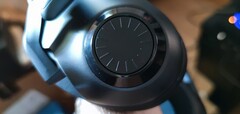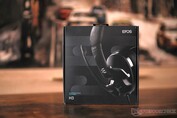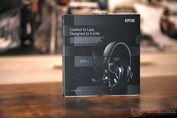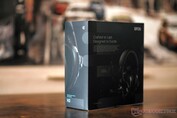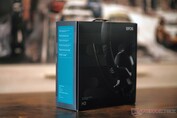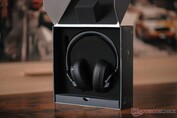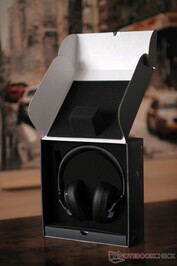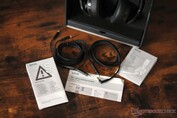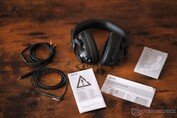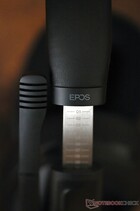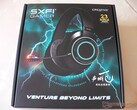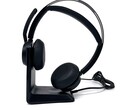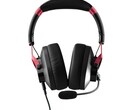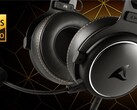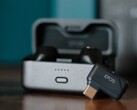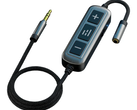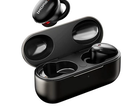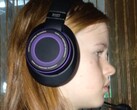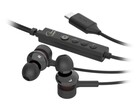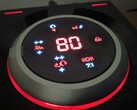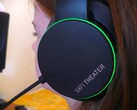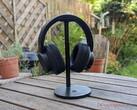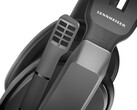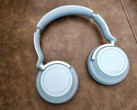Although it is the first in a new lineup of headsets, the EPOS H3 has a Sennheiser-branded sibling, namely the GSP 300, which is still available for purchase with a very tempting price tag of just US$79. Thankfully, we are not talking about a slightly modified GSP 300, but about a spiritual successor: the H3 is lighter, less bulky, with a completely different volume dial and headband.
Those who consider that the differences mentioned above are not enough to justify a price bump of US$50 should also keep in mind that the EPOS H3 comes with a GSA 50 hanger for free (priced at US$34.90 otherwise). Now, we need to take a closer look to see how much we get for the US$119 price tag of the EPOS H3.
Box contents, design, build quality
As it was the case with Sennheiser products in the past, the EPOS H3 comes in a carefully designed box, both on the outside and on the inside. Inside the box is everything needed to get started, namely the headset itself, two audio cables (one for PCs, and the other for consoles), as well as two printed guides (safety and quick start).
The headband design used by EPOS is less complicated than the military-grade headband found in most of the older headsets introduced as Sennheiser products (GSP 300, GSP 370, GSP 600, and a few others), but it's just as effective. In fact, the traditional leather band with a memory foam cushion used feels natural and allows the user to enjoy extended gaming sessions without any discomfort. The earcups are also very comfortable, although these days I sometimes felt like my ears were on the verge of boiling (not unexpected and to blame on the headset, since the ambient temperature is near 30 Celsius/86 Fahrenheit). However, I will get back to the ergonomics in the next section.
Regarding the build quality of the H3, there's nothing to complain about. All the materials used by EPOS feel solid and look great, the braided cables seem quite resilient, and the earcups also seem to be exactly what's needed. Since they are similar to those used in the GSP 370 (a headset that I keep enjoying from time to time and still looks like new after more than two years and probably well over 1,000 hours of use), I have no doubt about their durability.
Specs, features, real-life usage
The technical details revealed by the official fact sheet might miss the size of the drivers, but it's the sound they manage to deliver that really matters, right? In that department, the EPOS H3 sports a frequency response of 10 Hz to 30 kHz, 20 Ohm impedance, as well as a sound pressure level of 124 dB @ 1 kHz, 1 V RMS. The bidirectional microphone's frequency response starts at 10 Hz, but goes up to 18 kHz and its sensitivity value is - 47 dBV/PA.
The EPOS H3 is a dynamic, closed headset with a very comfortable fit that covers entirely even larger ears. The best part of it, although not advertised by EPOS at all, is that this headset is great for those who wear glasses as well. Overall, this headset is more comfortable than expected and it gets close to more expensive headsets in this department (the headband design makes it a better solution than the Creative SXFI THEATER, for example). While the microphone is not very easy to adjust, its arm is flexible to a certain degree.
Although I do not own a console, I used the EPOS H3 with a wide range of hardware, including an old Sony Walkman cassette player, the Sandisk Sansa e250 and Fiio M3 Pro digital media players, the Creative Sound Blaster X3 and EPOS GSX 1200 PRO USB DACs, as well as the Creative Sound BlasterX AE-5 Plus internal sound card. For testing the microphone's capabilities, a Tascam DR-10L micro linear PCM recorder was used in addition to the PC inputs available in the USB DACs and internal sound card mentioned above.
I usually enjoy lossless music, but I also listen to online radio shows that stream at 128 kbps that I record and do some basic editing on before adding them to my collection, not to mention games (mostly War Thunder, but also Armored Warfare and Ring of Elysium). The EPOS H3 delivers excellent, crisp sound with good stereo separation and enough bass, without offering excessive low end output as it happens with many gaming headsets. Since there is no digital processing involved, the entire experience is heavily influenced by the quality of the audio source.
This being said, if you come across reviews claiming that the EPOS H3 is heavy on bass, you should know that those reviews are not necessarily inaccurate. For example, when I listened to a tape on my Sony Walkman, the result wasn't exactly impressive and the sound seemed a bit washed out, lacking both mid and high-frequency details and with a narrow sound stage. The essential part is that, given good input, the EPOS H3 delivers as expected.
The microphone is very good for the usual in-game voice chat needs of the average user, but it does not reach studio quality. Although able to capture highs and mids properly, the microphone of the EPOS H3 would not be the best choice for a baritone who wants to play PUBG.
The good, the bad, and the truth
For me, the strongest parts of the EPOS H3 are the sound quality and the comfort provided, which is simply stellar for the price. The simplicity of this headset is certainly not a problem, so if you like the KISS design approach, you will love both the form and function of the EPOS H3.
The microphone is not detachable and that would be a solid improvement for those willing to take the headset with them on the road. After all, the H3 works great with most smartphones as well (I tested this with my old Xiaomi Mi A1 and a Realme 8 5G, in both cases the results were great). The volume control dial feels a bit awkward and I can surely live without ever touching it. However, those who use it will find its placement to be a bad choice because taking the hand off the mouse during a real-time game is not something anyone wants to do.
In an era when RGB lighting, USB connectivity, and 3D virtualization via the headsets' DSPs are ubiquitous, the EPOS H3 keeps things old school and does almost everything right. Slightly overpriced at first sight, this acoustic gaming headset is worth every penny and continues to surprise even after weeks of use across multiple scenarios.
Disclaimer: The author of this review received the EPOS H3 closed acoustic gaming headset from EPOS free of charge for the purpose of testing.




